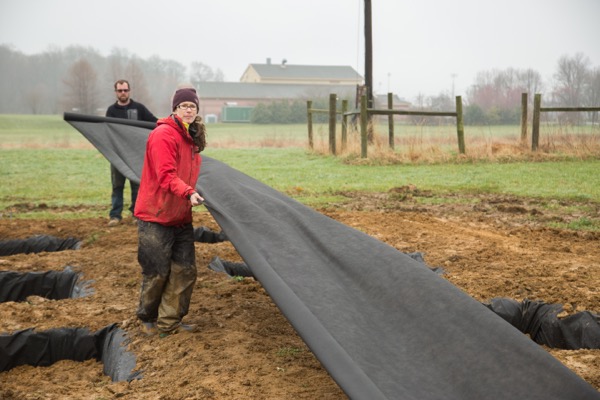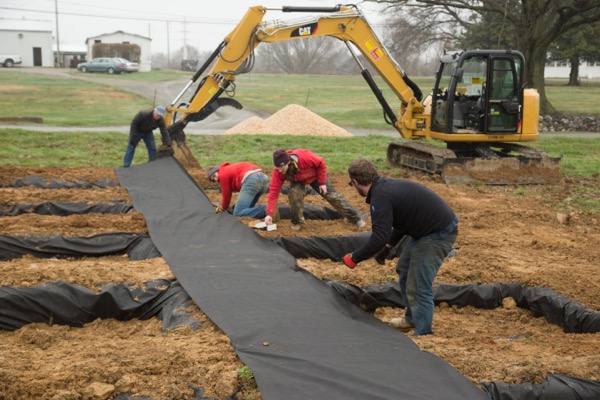RICE Facility
Rice paddies installed on CANR campus to aid arsenic research
11:27 a.m., April 28, 2015--Twelve paddies have been created at the University of Delaware’s new Rice Investigation, Communication and Education (RICE) Facility, an outdoor research education laboratory on the College of Agriculture and Natural Resources (CANR) campus, to assist scientist Angelia Seyfferth as she studies arsenic in rice.
The paddies were installed through a prestigious five-year $465,000 National Science Foundation (NSF) Faculty Early Career Development Award received by Seyfferth, who is an assistant professor in the Department of Plant and Soil Sciences. It was the first such award given to a CANR professor.
Research Stories
Chronic wounds
Prof. Heck's legacy
The new laboratory will allow for research that more closely resembles field conditions, allowing researchers to look at plants outdoors rather than solely in an indoor laboratory setting.
“Typically when we do experiments for plant growth, we are growing a few plants per pot and we can have multiple pots for multiple replicates to answer some scientific questions,” said Seyfferth. “But often what we do in the laboratory doesn’t translate to what is happening in the field because there are other factors that the plants are experiencing.”
Seyfferth said that while the rice paddies will still be controlled experiments, they will more closely approach field conditions.
“Rather than having three plants in a pot that are all growing together, we can have 50 plants in a plot of land, which is going to more closely resemble a rice paddy field. So this is what I like to call a rice mesocosm. The pot is almost like a microcosm and this is the mesocosm,” said Seyfferth.
Paddy construction
The rice paddies were installed by Jeta Excavation and Seyfferth also had design assistance from Jules Bruck, associate professor of landscape design, and Carmine Balascio, associate professor of plant and soil sciences.
Seyfferth said that Bruck and Balascio helped in terms of thinking about the logistical pieces of the project, such as what type of lining material to use in the paddies, how best to protect that liner and how to secure it.
“It went from this idea to a reality after talking with all these people who have a lot of experience with building and designing,” said Seyfferth.
The liners were used in the paddies to help prevent the water from infiltrating through the soil.
“We will be able to use less water and when we flood the paddies, arsenic naturally present in the soil will be mobilized and we don’t want it to go anywhere,” said Seyfferth. “Typically, rice is grown in very high clay content soils where you can pack the clay down or there’s some sort of a hard pan that will trap the water. Here we don’t really have that so we’re artificially creating it. The whole goal is to do these replicated field experiments without potentially impacting other areas.”
Seyfferth also acknowledged her lab group as a whole for helping in the construction, noting that Andrew Morris, a research assistant, and Matt Limmer, a postdoctoral fellow, provided much help in the process.
Growing rice
Seyfferth said that the end of May is when the soil temperatures are warm enough to support the types of rice her group wants to grow. The rice will be germinated indoors and then transplanted to the paddies by the beginning of June, and harvested in September.
Because the rice grows in flooded conditions, Seyfferth said it helps to minimize unwanted plant growth because weeds do not do well in the flooded soils where rice thrives. That is a benefit because the researchers will not have to use large quantities of herbicides to control weeds.
“Flooding the soil also makes phosphorous more available, so we don’t expect to need to use phosphorous fertilizer at least for the first year,” said Seyfferth. “In most upland soils, places where corn, soy and everything else is grown, the phosphorous is typically very tightly held onto the soil and you have to add more phosphorous for increased productivity. For the rice, the same processes that will release arsenic will also release phosphorous, so there’s minimal fertilizer inputs that we need to worry about.”
International Year of Soils
The RICE Facility will host the inaugural Soil is Life one-day summer camp for middle school students this year, and Seyfferth said that because 2015 is the International Year of Soils, it is perfect timing.
“It’s really exciting to have the inaugural camp of Soil is Life happen to coincide with this International Year of Soils,” said Seyfferth.
Campers will study the rice and also some adjacent soil pits where they will be shown the soil profile and talk about the importance of soil and where their food comes from.
Seyfferth said that in addition to studying rice, campers will have opportunities to study other crops growing nearby, including a cornfield, a vegetable garden and an organic high tunnel put in place by CANR Dean Mark Rieger.
“There will be a lot of opportunities for the students to learn about many different types of food production in a small space,” said Seyfferth.
Now that the paddies have been installed, Seyfferth said she is eager to get started on the experiments.
“I think we’re just very excited that this idea was not only able to get funded but is now a reality. I think it provides potential new collaborations for the future with other faculty who are working on rice,” said Seyfferth. “I’m very excited about the project and can’t wait to see what comes of it.”
Article by Adam Thomas
Photos by Lindsay Yeager












